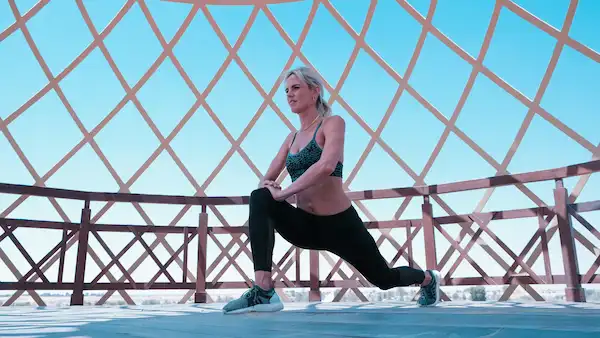You don’t need an hour-long elaborate morning ritual to feel energized and strong. A simple 10-minute routine can transform how you feel physically and mentally throughout your entire day – especially when you’re 60+ and want to start each morning feeling capable and confident in your body.
I understand the frustration of reading about morning routines that seem designed for people half your age with unlimited time and energy. You’re looking for something realistic that fits into your actual life, acknowledges where your body is right now, and doesn’t require you to become a different person overnight.
The truth is, consistency beats complexity every single time. A 10-minute routine you’ll actually do is infinitely more valuable than a 45-minute plan that lives only in your head.
Why 10 Minutes Is the Sweet Spot After 60
Your body processes movement differently now than it did decades ago. You need gentle activation, not aggressive challenge, first thing in the morning. Ten minutes gives you enough time to wake up your joints, muscles, and circulation without overwhelming your system or creating unnecessary fatigue.
Research from the American College of Sports Medicine shows that adults over 60 benefit most from consistent, gentle movement patterns that support daily function. Your morning routine should prepare your body for whatever your day holds, not leave you feeling depleted before you even start.
Here’s what I’ve learned from working with hundreds of adults 60 and beyond: The routines that become lifetime habits are the ones that honor where your body is today. Ten minutes creates that perfect balance between meaningful movement and realistic expectations.
What Makes a Morning Routine Actually Work
After years of trial and error (my own and my clients’), I’ve identified the non-negotiable elements that separate routines you’ll abandon after a week from ones you’ll still be doing years from now.

Effective morning routines for adults 60+ must include:
- Joint mobility work (your body has been stationary for 6-8 hours)
- Gentle activation of major muscle groups
- Something that improves circulation without strain
- A movement that makes you feel accomplished and capable
They absolutely cannot include:
- Equipment stored in hard-to-reach places
- Movements that cause pain or significant stiffness
- Anything requiring perfect balance from day one
- Routines that leave you feeling tired instead of energized
The goal isn’t to prove you can still do what you did at 40. The goal is to move from “morning stiffness” to “ready for whatever comes next” in exactly 10 minutes.
Be sure to read The Only 5 Pieces of Exercise Equipment You Need After 60.
The Foundation Routine (Perfect for Beginners)
This routine works whether you’re getting back into movement after years away or you’ve never had a consistent exercise habit. Every single movement can be done next to your bed in whatever you slept in.

Minutes 1-2: Wake Up Your Spine Start lying down (yes, you can begin this routine in bed). Gently pull one knee toward your chest, hold for 15 seconds, then switch legs. Follow with both knees to chest for 30 seconds. This tells your lower back that it’s time to move.
Minutes 3-4: Shoulder and Neck Release Sit on the edge of your bed. Roll your shoulders backward 10 times, then forward 10 times. Gently turn your head left and right 5 times each direction. These simple movements address the most common morning stiffness complaints.
Minutes 5-6: Get Your Blood Moving Stand up and march in place for 60 seconds. If marching feels too energetic, simply shift your weight from foot to foot while moving your arms. The goal is gentle circulation, not cardio intensity.
Minutes 7-8: Core Activation Without Strain Place your hands on a dresser or wall. Step back slightly and do 10 gentle push-ups against the surface. This wakes up your core, arms, and chest without requiring you to get on the floor.
Minutes 9-10: Balance and Confidence Hold onto something sturdy and practice standing on one foot for 15 seconds, then switch. End by reaching your arms overhead and taking three deep breaths. You’ve just told your body it’s ready for the day.
This routine addresses the three biggest concerns I hear from adults starting movement routines: “Will it hurt?”, “Can I do it in my current physical condition?”, and “Will I be able to stick with it?” The Foundation Routine answers all three with a confident “yes.”
The Energy Booster Routine
For days when you wake up feeling sluggish or need extra mental clarity. This routine specifically targets circulation and gentle activation to combat morning fog.

Minutes 1-2: Spinal Wave Sit on the edge of your bed. Place your hands on your knees and slowly round your back, then arch it gently. Repeat 10 times. This movement pattern helps cerebrospinal fluid circulation, which affects mental clarity.
Minutes 3-4: Dynamic Arm Circles Stand and make large, slow circles with your arms – 10 forward, 10 backward. Then make smaller, faster circles for 30 seconds. This movement pattern increases upper body circulation more effectively than static stretches.
Minutes 5-6: Modified Sun Salutation From standing, sweep your arms overhead, then hinge at your hips to reach toward the floor (only go as far as comfortable). Rise back up with arms overhead. Repeat 8 times. This full-body movement wakes up everything at once.
Minutes 7-8: Gentle Cardio Burst Choose your intensity: step-touches with arm swings, marching with high knees, or dancing to one favorite song. The key is moving continuously for 2 minutes at whatever pace feels energizing, not exhausting.
Minutes 9-10: Energizing Breath Work Stand tall, inhale for 4 counts while raising your arms, hold for 2 counts, exhale for 6 counts while lowering your arms. Repeat 8 times. This breathing pattern specifically increases oxygen delivery and mental alertness.
I’ve used this routine on mornings when I’ve felt mentally foggy or physically sluggish, and it consistently shifts my energy within those 10 minutes. The key is listening to your body’s response and adjusting intensity accordingly.
The Strength Builder Routine
Designed for days when you want to feel strong and capable. This routine focuses on functional movements that support daily activities.
Minutes 1-2: Joint Preparation Start with ankle circles (10 each direction, both feet), then gentle knee lifts (10 each leg), followed by arm circles (10 each direction). This prepares your joints for load-bearing movements.
Minutes 3-4: Chair-Supported Squats Using a sturdy chair for balance, perform 12-15 squats. Focus on sitting back into the movement rather than dropping straight down. This movement pattern supports every daily activity from getting out of cars to climbing stairs.

Minutes 5-6: Wall Push-Ups Plus Position yourself arm’s length from a wall. Perform 15 wall push-ups, then hold the bottom position for 10 seconds on the last one. This builds functional upper body strength without floor exercises.
Minutes 7-8: Core Integration Stand with feet hip-width apart. Lift one knee toward the opposite elbow, alternating sides for 20 repetitions total. This movement integrates core strength with balance and coordination.
Minutes 9-10: Functional Hold End with a 30-second supported single-leg stand (holding onto something), followed by reaching overhead and holding for 30 seconds. These holds build the stability strength you use dozens of times every day.
This routine builds real-world strength – the kind that makes carrying groceries, getting up from chairs, and maintaining balance feel easier. I’ve seen clients gain noticeable functional strength within weeks of consistent practice.
How to Choose Your Routine
Start with the Foundation Routine if:
- You’re new to regular movement
- You’re returning to exercise after a break
- You have mobility limitations or chronic pain
- You want something you can do regardless of how you feel
Use the Energy Booster when:
- You wake up feeling mentally foggy
- You have a particularly busy or stressful day ahead
- You want to feel more alert and energized
- You slept poorly and need a gentle wake-up
Choose the Strength Builder if:
- You want to feel capable and strong
- You’re preparing for physical activities later
- You want to maintain or build functional strength
- You’re feeling good and want a bit more challenge
Here’s the insider knowledge most fitness advice misses: You don’t have to stick with one routine forever. I rotate between all three based on how I feel when I wake up, and this flexibility is exactly what makes the habit sustainable.
The key question isn’t “Which routine is best?” but rather “Which routine will I actually do today?” Honor where your body is each morning, and you’ll create a practice that lasts.
Making It Stick: The Reality Check
Let’s address the elephant in the room: You’ve probably tried morning routines before and stopped. I understand the frustration of starting something with good intentions only to abandon it within weeks.

Here’s what I’ve learned from clients who successfully made morning movement a permanent habit versus those who didn’t:
The successful ones:
- Started with routines that felt almost too easy
- Gave themselves permission to modify movements
- Focused on consistency over intensity
- Celebrated showing up, not perfect execution
The ones who struggled:
- Chose routines that felt like punishment
- Tried to be perfect from day one
- Compared their beginning to someone else’s middle
- Quit after missing a few days
Your morning routine should feel like self-care, not another obligation. If you wake up dreading your 10 minutes, the routine is wrong for you right now, not the other way around.
I give you full permission to make these routines easier. Can’t do wall push-ups? Do them against a kitchen counter. Can’t balance on one foot? Hold onto something with both hands. The movement that happens is infinitely better than the perfect movement that doesn’t.
Start with just three days this week. Pick the same three days each week for the first month. Consistency in timing builds stronger habits than daily attempts that fail.
Frequently Asked Questions
What if I can’t do 10 minutes when I first start? Start with 5 minutes, or even 3. The habit of moving every morning matters more than the duration. I’ve had clients begin with just standing up and sitting down five times. After two weeks, they naturally wanted to do more. Your body will tell you when it’s ready to expand.
Should I do the same routine every day? Absolutely not. Variety prevents boredom and addresses different physical needs. Listen to your body each morning. Stiff and creaky? Foundation Routine. Foggy and sluggish? Energy Booster. Feeling strong? Strength Builder. This intuitive approach builds body awareness alongside physical fitness.
What if I miss several days in a row? You haven’t failed – you’ve learned something about your current capacity or schedule. The best time to restart is right now, not Monday or next month. Don’t try to “make up” for missed days. Simply choose one routine and begin again. Guilt is not a motivator; self-compassion is.
Is it normal to feel sore after starting these routines? Some mild muscle awareness is normal, especially if you’ve been sedentary. Sharp pain, joint discomfort, or soreness that worsens over several days is not normal. Reduce the intensity, modify movements, or consult your healthcare provider. These routines should make you feel better, not worse.
Can I do these routines if I have arthritis or other chronic conditions? Many of my clients with arthritis, diabetes, heart conditions, and other chronic issues successfully use modified versions of these routines. Always check with your healthcare provider before starting any new movement practice. Most can be adapted – wall push-ups instead of floor push-ups, seated marching instead of standing, holding onto furniture for balance work.
What’s the best time to do my morning routine? The best time is whenever you’ll actually do it consistently. Some clients do theirs immediately upon waking, others after their first cup of coffee, some after getting dressed. Experiment to find what works with your natural rhythms and daily schedule. Consistency in timing helps build the habit faster.
Troubleshooting Common Challenges
“I keep forgetting to do my routine” Link your routine to something you already do every morning. Do it right after brushing your teeth, or while your coffee brews, or immediately after letting the dog out. Visual cues help too – leave comfortable shoes by your bed or put a note on your bathroom mirror.
“I feel silly doing exercises in my bedroom” This feeling is completely normal and usually fades within a week. You’re not performing for anyone – you’re caring for yourself. If privacy helps, close your bedroom door. Remember, taking care of your body is never silly, regardless of your age or fitness level.
“Some movements feel awkward or unnatural” Your body needs time to remember movement patterns, especially if you’ve been sedentary. Awkward is normal; painful is not. Focus on the intention of the movement rather than perfect form. Most movements feel more natural after 7-10 repetitions over several days.
“I don’t feel energized afterward – I feel tired” You might be pushing too hard or choosing the wrong routine for your current energy level. Try the Foundation Routine for a week, moving slower and with less intensity. If you still feel depleted, consult your healthcare provider. Morning movement should energize, not exhaust.
Your Success Plan
Week 1-2: Establishment Choose one routine. Do it 3 days this week, 4 days next week. Focus solely on showing up, not performance. Success is measured by consistency, not intensity.
Week 3-4: Refinement Try all three routines to find your preferences. Begin matching routines to your daily energy levels. Notice how different movements affect how you feel throughout the day.
Week 5-8: Integration Your routine should feel automatic by now. This is when you’ll notice the most significant improvements in daily function and energy levels. Consider adding 2-3 minutes if you consistently want more.
Month 3 and Beyond: Lifestyle Your morning routine has become self-care, not exercise. You do it because you feel better when you do, not because you have to. This is the goal – movement as medicine, not punishment.
Your Next Step Forward
A 10-minute morning routine that you actually do is more powerful than any hour-long workout you keep postponing. You now have three proven routines designed specifically for your body and your life.
Choose one routine – whichever feels most doable right now. Set out whatever you need the night before (comfortable clothes, a sturdy chair, clear floor space). Tomorrow morning, give yourself the gift of 10 minutes that are just for you.
Your body is capable of more than you might believe right now, but it needs consistent, gentle encouragement to show you what’s possible. These routines provide exactly that – a daily reminder that you’re worth 10 minutes of care and attention.
You’re not trying to become someone else. You’re supporting who you already are. Every morning you choose to move is a morning you choose to invest in feeling better, stronger, and more confident in your body.
At 60+, you have the wisdom to know what truly matters and the life experience to appreciate simple, effective solutions. These routines honor both your wisdom and your body’s current needs.
Your morning movement practice is an investment that pays dividends all day long. Better balance for navigating stairs. Improved strength for carrying groceries. Enhanced energy for whatever brings you joy.
Start tomorrow. Your body is ready, even if your mind has doubts. Ten minutes of gentle movement is always better than zero minutes of perfect intention.
Last Updated: June 2025





